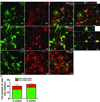Focal cerebral ischemia induces a multilineage cytogenic response from adult subventricular zone that is predominantly gliogenic
- PMID: 20578055
- PMCID: PMC2919586
- DOI: 10.1002/glia.21033
Focal cerebral ischemia induces a multilineage cytogenic response from adult subventricular zone that is predominantly gliogenic
Abstract
The purpose of this study was to ascertain the relative contribution of neural stem/progenitor cells (NSPCs) of the subventricular zone (SVZ) to lineages that repopulate the injured striatum following focal ischemia. We utilized a tamoxifen-inducible Cre/loxP system under control of the nestin promoter, which provides permanent YFP labeling of multipotent nestin(+) SVZ-NSPCs prior to ischemic injury and continued YFP expression in all subsequent progeny following stroke. YFP reporter expression was induced in adult male nestin-CreER(T2):R26R-YFP mice by tamoxifen administration (180 mg kg(-1), daily for 5 days). Fourteen days later, mice were subjected to 60-min transient middle cerebral artery occlusion (MCAO) and sacrificed at 2 days, 2 weeks, or 6 weeks post-MCAO for phenotypic fate mapping of YFP(+) cells using lineage-specific markers. Migration of YFP(+) cells from SVZ into the injured striatal parenchyma was apparent at 2 and 6 weeks, but not 2 days, post-MCAO. At 2 weeks post-MCAO, the average percent distribution of YFP(+) cells within the injured striatal parenchyma was as follows: 10% Dcx(+) neuroblasts, 15-20% oligodendrocyte progenitors, 59% GFAP(+) astrocytes, and only rare NeuN(+) postmitotic neurons. A similar phenotypic distribution was observed at 6 weeks, except for an increased average percentage of YFP(+) cells that expressed Dcx(+) (20%) or NeuN (5%). YFP(+) cells did not express endothelial markers, but displayed unique anatomical relationships with striatal vasculature. These results indicate that nestin(+) NSPCs within the SVZ mount a multilineage response to stroke that includes a gliogenic component more predominant than previously appreciated.
(c) 2010 Wiley-Liss, Inc.
Figures






Similar articles
-
Dynamic contribution of nestin-expressing stem cells to adult neurogenesis.J Neurosci. 2007 Nov 14;27(46):12623-9. doi: 10.1523/JNEUROSCI.3812-07.2007. J Neurosci. 2007. PMID: 18003841 Free PMC article.
-
Sildenafil enhances neurogenesis and oligodendrogenesis in ischemic brain of middle-aged mouse.PLoS One. 2012;7(10):e48141. doi: 10.1371/journal.pone.0048141. Epub 2012 Oct 31. PLoS One. 2012. PMID: 23118941 Free PMC article.
-
Fate mapping and lineage analyses demonstrate the production of a large number of striatal neuroblasts after transforming growth factor alpha and noggin striatal infusions into the dopamine-depleted striatum.Stem Cells. 2008 Sep;26(9):2349-60. doi: 10.1634/stemcells.2008-0080. Epub 2008 Jun 12. Stem Cells. 2008. PMID: 18556510 Free PMC article.
-
Comparison of cortical and white matter traumatic brain injury models reveals differential effects in the subventricular zone and divergent Sonic hedgehog signaling pathways in neuroblasts and oligodendrocyte progenitors.ASN Neuro. 2014 Sep 23;6(5):1759091414551782. doi: 10.1177/1759091414551782. Print 2014. ASN Neuro. 2014. PMID: 25290062 Free PMC article.
-
Characterization of endogenous neural progenitor cells after experimental ischemic stroke.Curr Neurovasc Res. 2010 Feb;7(1):6-14. doi: 10.2174/156720210790820208. Curr Neurovasc Res. 2010. PMID: 20158467
Cited by
-
The shh signaling pathway is upregulated in multiple cell types in cortical ischemia and influences the outcome of stroke in an animal model.PLoS One. 2015 Apr 30;10(4):e0124657. doi: 10.1371/journal.pone.0124657. eCollection 2015. PLoS One. 2015. PMID: 25927436 Free PMC article.
-
The Role of Stem Cells in the Treatment of Cerebral Palsy: a Review.Mol Neurobiol. 2017 Sep;54(7):4963-4972. doi: 10.1007/s12035-016-0030-0. Epub 2016 Aug 13. Mol Neurobiol. 2017. PMID: 27520277 Review.
-
Inhibition of Notch 1 signaling in the subacute stage after stroke promotes striatal astrocyte-derived neurogenesis.Neural Regen Res. 2023 Aug;18(8):1777-1781. doi: 10.4103/1673-5374.363179. Neural Regen Res. 2023. PMID: 36751805 Free PMC article.
-
Persistent myelin abnormalities in a third trimester-equivalent mouse model of fetal alcohol spectrum disorder.Alcohol Clin Exp Res. 2022 Jan;46(1):77-86. doi: 10.1111/acer.14752. Epub 2021 Dec 15. Alcohol Clin Exp Res. 2022. PMID: 34825395 Free PMC article.
-
Roles for HIF-1α in neural stem cell function and the regenerative response to stroke.Behav Brain Res. 2012 Feb 14;227(2):410-7. doi: 10.1016/j.bbr.2011.08.002. Epub 2011 Aug 18. Behav Brain Res. 2012. PMID: 21871501 Free PMC article. Review.
References
-
- Alvarez-Buylla A, Lim DA. For the long run: maintaining germinal niches in the adult brain. Neuron. 2004;41(5):683–686. - PubMed
-
- Arvidsson A, Collin T, Kirik D, Kokaia Z, Lindvall O. Neuronal replacement from endogenous precursors in the adult brain after stroke. Nat Med. 2002;8(9):963–970. - PubMed
-
- Burns KA, Ayoub AE, Breunig JJ, Adhami F, Weng WL, Colbert MC, Rakic P, Kuan CY. Nestin-CreER Mice Reveal DNA Synthesis by Nonapoptotic Neurons following Cerebral Ischemia-Hypoxia. Cereb Cortex. 2007 - PubMed
Publication types
MeSH terms
Substances
Grants and funding
LinkOut - more resources
Full Text Sources
Miscellaneous

